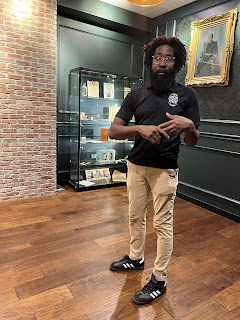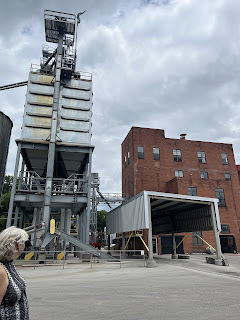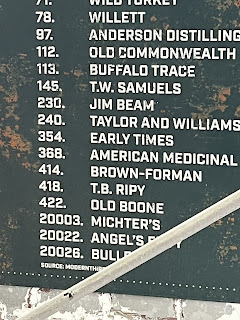While in Owensboro, Meral and I toured the Green River Distillery. Right away you're greeted by advertising after the Prohibition painted upon one of the brick buildings.
I never made the effort to come a day or two earlier or stay a bit later when working in Louisville to tour a bourbon distillery. We had driven 2 hours from Louisville to Owensboro for ROMP, and I was mighty glad that there was a distillery right in town for me and Meral to tour--me because I used to love drinking Kentucky bourbon neat and Meral because she's a bartender and dabbles in mixology.
There are so many breweries in Kentucky, and I'm glad to finally have gotten far enough out of Louisville and find one in Owensboro. And here's a flowering bush I'd never seen before.We had a lovely tour guide in Day Ogisi, who originates from New Orleans and a family of psychologists and studied accounting for a career. He knew a little bit about the Bay Area because his brother once lived in Sausalito. He told us about the original founder of Green River Whiskey, J.W. McCulloch, who originally was a tax collector for the Internal Revenue Service. One of the themes of McCulloch's advertising was the front side of the label featuring a horseshoe and the slogan "The Whiskey Without a Headache," which after Prohibition had to be changed because medical claims in advertising whiskey were forbidden. Day led us outdoors to the where the mash was being made in the stainless steel cooker with milled corn, and to which yeast was added. Outside smelled like bread rising and sweetness and added to the infernally hot temperature.
Mashing or heating the grains converts the starch in the corn and rye or wheat into fermentable sugars. Inside the entrance and on the first floor of the distillery, we could see an outline of the steps to making the whiskey.
The Green River has been owned by several owners throughout its history, but the Bardstown Bourbon Company has restored its original name in homage to Green River Distilling Company being the 10th oldest distillery in the United States (indicated by DSP #10 or the 10th registered distillery in Kentucky--a license number that never goes away even as a distillery changes hands and names). I saw that my favorite, Four Roses was older being the 8th oldest and one I grew to like later and became very popular--Angel's Envy one of the very newest.
The good smells continued upstairs in the distillery and emitted from the fermentation tanks. Day had explained that before Prohibition, the distillery had burned down in 1918 and only recently rebuilt again by the Bardstown group after being moribund in the 1980s.
Day opened the lid of one of the fermenters, and one could see the mash simmering and bubbling away as the yeast converted the sugars into alcohol in those 3 to 5 days of fermentation.
Copper!
Here's where the distillery endeavors to be the "whiskey without regrets" as it lets the liquor boil and condense and remove impurities.Described by the Green River Distiller, "Green River Kentucky Straight Bourbon Whiskey is 90 proof and has been aged more than five years at the distillery in Owensboro. It is rich in color with an amber hue and made with all Kentucky-grown corn, most from Daviess County. The mash bill is 70% corn, 21% winter rye, and 9% malted 2 and 6-row barley. The higher rye content results in a bourbon with warming spice notes on the nose and palate. Additional aroma notes to look for include cinnamon, dried cherry, and light leather. For taste, it has notes of cinnamon, vanilla, caramel, and chocolate mint. The finish is rich, thick, and lingering."
We then toured a bourbon warehouse or rickhouse, one of which I photographed at the beginning of this blog post and where barrels of whiskey are aged and stored. Green River ages their whiskey in charred oak barrels (which are only used once), and aging mellows the bite of the alcohol and lets the wood impart flavor to the spirit. The rickhouses built on this campus are not actual brick but of ceramic. Temperature changes in the weather evaporate bourbon in and out of the barrels--the bourbon lost to evaporation is called "Angel's Share."
Barrels are generally stored in the rickhouse on their side in wooden framed “ricks”, or racks, which here span 3 barrels high on each floor. Sweet notes in bourbon come from the wood sugars that caramelize during the toasting process, and below is the very first barrel produced at Green River signed by all the employees.
We returned to the event space building to the tasting room. We tasted first the wheated bourbon, but I liked the second or less spicy Green River Kentucky Straight Bourbon Whiskey the best.
We also got to taste the Devil's Cut. The raw whiskey's portion that is absorbed and trapped in the barrel's wood is known as the Devil's Cut. I couldn't finish my shot as I was already woozy from sipping the first two shots. I've become such a lightweight now at imbibing bourbon.
The bottle for Green River is unique. The raised horseshoe at the bottom of the bottle allows you to play quarter hockey when the bottle is upright. I played at ROMP and got a pin as well as a sticker from the distillery.
I'm now one who can no longer sip bourbon neat and prefer it now in an Old Fashion.I watched this gentleman roll a barrel of bourbon to be delivered to another rickhouse for aging and storage.






























No comments:
Post a Comment